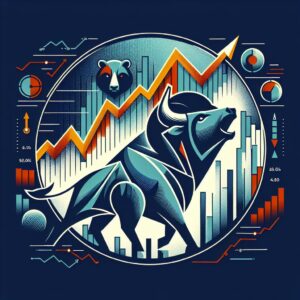Summary
The page titled ‘Challenges Faced by Active Managers in Outperforming Market Indexes’ details the difficulties encountered by active managers when attempting to surpass market indexes through their strategic trading and analytical skills. Active managers, also known as fund managers, employ various methodologies in order to achieve greater returns than a specified benchmark. However, they face numerous challenges, including the need to draw meaningful comparisons within the same asset class, exogenous systematic factors that can significantly complicate the evaluation process, and the need to ensure shorter horizon returns for a more accurate assessment. Despite the high costs associated with active management and the increased scrutiny from the influx of skilled analysts over the past 50 years, a small fraction of active managers have succeeded in outperforming market indexes, mostly due to superior expertise, skill, and judgment employed in active portfolio management. This page further discusses the role of alpha in evaluating active managers’ performance, case studies of successful active managers, and recent trends in active management.
Overview
Active managers, often described as fund managers, utilize their analytical and trading skills in an attempt to outperform a given benchmark. These managers are often evaluated and compared based on their performance relative to each other or the market itself, utilizing various indices such as the Jensen Index.
However, there are inherent challenges when it comes to comparing performance. Particularly, it is crucial to compare funds within the same asset class. Drawing comparisons between funds from different asset classes (e.g., comparing a large-cap growth fund to an emerging markets fund) is not meaningful as it is akin to comparing apples to oranges.
In addition to this, there are exogenous systematic factors that can influence the availability of alpha (a measure of performance) for managers, especially those dealing with large-cap core investments. These factors can significantly complicate the evaluation process of active managers’ performance.
To ensure a more accurate assessment, a focus on shorter horizon returns (1 year as opposed to 5-10 years) was suggested. This approach helps minimize the influence of survivorship and selection bias, which can distort long-term return calculations and active share statistics. The adoption of such methods aims to provide a more comprehensive perspective on the assessment of manager skill.
Active Management
An active manager employs more aggressive strategies with the objective of outperforming the market . This individual, a professional money manager, or a team of professionals actively track the performance of an investment portfolio and make buy, hold, and sell decisions about the assets in it . The overarching goal of any investment manager is to outperform a designated benchmark while accomplishing other goals, such as managing risk, limiting tax consequences, or adhering to environmental, social, and governance (ESG) standards for investing .
Active management is often contrasted with passive management, which designs a portfolio to be representative of a market-weighted index . Active management has been popular among investors due to the strategy’s flexibility, including the ability to react quickly to unforeseen changes in the market or global events . However, the approach comes with higher fees to pay for the time, energy, and resources active managers devote to researching market trends and adjusting the investments to increase the likelihood of success . These fees can potentially reduce the overall returns, meaning that an actively managed fund has to outperform its benchmark by a significant margin for individual investors to profit .
Benchmark performance plays a significant role in active management. Benchmarks are often used as tools to assess the allocation, risk, and return of a portfolio . They are usually constructed using unmanaged indices, exchange-traded funds (ETFs), or mutual fund categories representing each asset class . These measures are commonly reported with managed investment funds and also by index providers . Fund companies use benchmarks as a gauge for the performance of a portfolio against its investing universe. Active managers aim to outperform these benchmarks .
Yet, outperforming the market proves to be a challenge for many active managers. Research indicates that only about 22% of actively managed funds have beaten the S&P 500 index over the last decade . Also, data consistently show that a majority of actively managed mutual funds fail to outperform market averages reported by various indexes such as the Dow Jones Industrial Average, Standard and Poor’s (S&P) 500, and Wilshire 5000 .
An active manager’s strategy can be influenced by market sentiment, a qualitative disposition that results from numerous unobservable factors and impacts the decision-making of investors . By harnessing advancements in text mining, machine learning, and sentiment analysis, researchers can extract valuable information from social platforms that reflect investor sentiment . However, market sentiment can lead to overinvestment during periods of high sentiment and underinvestment in anticipation of future profitability .
Active managers face additional challenges due to the significant growth of the financial industry over the last 50 years. The influx of skilled analysts applying sophisticated analytical techniques to the markets has increased scrutiny on their behavior . Simultaneously, the enlarged assets under management (AUM) make discrete operation more challenging for active managers . As noted, the fees for actively managed funds are substantially higher than those of the passive funds they often fail to beat .
Market Indexes
A market index is a collection of securities from the same industry or of companies that have a similar size in terms of market capitalization. The term is also used as a comparison of performance between two securities, where the better performing of the two is said to outperform the other. Companies are likely to outperform their peers when they efficiently manage their production and marketing efforts.
On the other hand, passive management represents designing one’s portfolio to be representative of a market-weighted index. This approach eliminates the market risk associated with trying to beat the market, as there is less probability of human error in selecting the index stocks. Passive management has been widely adopted by mainstream investors, spearheaded by the mutual fund company Vanguard.
Challenges Faced by Active Managers in Outperforming Market Indexes
One of the consistent problems active managers encounter, as identified by Ganti, includes higher fees compared to index fund fees, the lack of information advantage in a market dominated by professional traders, and the difficulty in pre-emptively selecting outperforming stocks in a year where only a minority of stocks typically outperform. These higher fees, which pay for the resources active managers devote to researching market trends and making investment adjustments, can eat into overall returns. This means that to benefit individual investors, an actively managed fund must outperform its benchmark by a significant margin.
Moreover, the growth in the financial industry over the last 50 years has seen an increase in smart analysts employing sophisticated analytical techniques in the markets. This has compounded the challenges for active managers, with increased scrutiny of their behavior and the growth of their assets under management (AUM) limiting their ability to operate discreetly. The costs associated with active management, such as seeking out securities for superior performance, also make them more expensive than passively managed index funds.
Market volatility also impacts the operations of active managers. An example is the year 2022, which presented unconventional challenges for active managers navigating clients’ portfolios in a volatile market. On the other hand, a stock outperforms when it exceeds major market indexes such as the S&P 500 or Dow Jones. However, many factors, such as revenue, stock price increases, strategic shifts, market capitalization, and investor sentiment, are crucial to achieving outperformance.
The focus on managers with positive “alpha”, or outperformance relative to a benchmark or asset pricing model, is often subjected to the debate of whether the outperformance in the past is a result of skill or merely good luck. Notably, active managers have historically had higher costs than passive managers, which Ganti suggests contributes to the high underperformance rates among active managers.
Despite the challenges faced by active managers, it is important to note that a small portion of managers has managed to outperform over the long term. This is often due to superior expertise, skill, and judgment employed in active portfolio management. However, these challenges have fueled a shift towards passive investing, characterized by designing a portfolio that mirrors a market-weighted index.
Strategies and Tactics to Overcome Challenges
Active managers are often confronted with numerous challenges in their attempt to outperform market indexes. Overcoming these obstacles necessitates a thoughtful strategy and tactical approach to problem-solving.
Active Portfolio Management
In active portfolio management, managers make strategic decisions about buying and selling assets with the aim of outperforming the broader market’s performance. This strategy requires a team of professionals to monitor the investment portfolio’s performance and make informed decisions based on research, forecasts, and judgment.
Maintaining Employee Productivity
One of the most common difficulties for managers is maintaining and boosting employee productivity. A decrease in productivity can impact team dynamics and overall objectives. To address this, managers can regularly review company processes and procedures to increase efficiency. It is also crucial to solicit feedback from team members about their work and communication challenges. Implementing viable suggestions can demonstrate the manager’s active listening and commitment to addressing their concerns.
Handling Workplace Tensions
Managers often have to deal with employees who create tensions in the workplace. A proactive approach to identifying and addressing potential issues before they escalate can prevent larger problems.
Building Management Skills
For first-time managers, lack of experience in leading a team can result in difficulties in setting clear goals, communicating effectively, and providing constructive feedback. Companies can help these managers by providing training and development programs to build their leadership and management skills.
Using Benchmarks
Benchmarks are an important tool for assessing a portfolio’s allocation, risk, and return. Comparisons can be made for any period to evaluate the portfolio’s performance. Portfolio managers generally choose a benchmark that aligns with their investing universe. Active managers aim to exceed their benchmark performance.
Understanding Market Sentiment
Understanding market sentiment, defined as the overall optimism or pessimism towards risky assets, is a critical factor in making investment decisions. However, this is often challenging due to the difficulty in quantifying human sentiment. Advances in natural language processing and sentiment analysis can help extract valuable insights from social platforms.
Balancing Investment Decisions
Finally, balancing investment decisions in response to market sentiment is also critical. While financial flexibility can lead to overinvestment, the expectation of future profitability can cause firms to underinvest during high sentiment periods. Therefore, understanding and navigating these dynamics is crucial for active managers to outperform market indexes.
Role of Alpha in Evaluating Active Managers’ Performance
In evaluating the performance of active managers, alpha and beta are significant concepts. Alpha, in particular, is a measure of the excess return on an investment after adjusting for market-related volatility and random fluctuations. It’s a crucial indicator used to understand if an asset has performed better or worse than its beta predicts.
Alpha is also a performance ratio compared to a benchmark index, such as the S&P 500. For instance, an alpha of one indicates that the investment return during a specific timeframe outperformed the overall market average by 1%. Conversely, a negative alpha number signifies underperformance compared to the market average.
The concept of alpha is part of five popular technical investment risk ratios used in modern portfolio theory (MPT). These include beta, standard deviation, R-squared, and the Sharpe ratio. All these indicators are designed to help investors understand the risk-return profile of an investment. Active managers often strive to generate alpha in diversified portfolios, intending to eliminate unsystematic risk.
However, achieving alpha depends on unique market circumstances and the investment approach. The debate persists about whether the outperformance is due to skill or luck. Some scholars argue that beating the market is more about luck than skill. With numerous funds in the universe, many might show statistically significant alphas due to chance, even when there is no skill involved.
Case Studies of Active Managers Outperforming Market Indexes
Despite the general trend of active managers’ underperformance, there have been cases of success among active managers. Over a decade ending in 2021, active managers who specialized in domestic small growth stocks were more likely to beat the index. A study demonstrated that in this category, approximately 88% of active managers outperformed their benchmark index before the deduction of fees . This indicates that while the general performance of active managers may be controversial, certain niches in the market allow for the potential of higher returns.
In addition to tactical asset allocation, active managers can also mitigate risk by implementing various hedging strategies such as short selling and utilizing derivatives . While these strategies do not guarantee success, they can provide a buffer against potential losses. Despite the overall trend of underperformance, these case studies illustrate that there are opportunities within the market for active managers to achieve superior returns.
Recent Trends in Active Management
The active asset management strategy has become popular among investors due to several attractive upsides. It allows for prompt reaction to unexpected shifts in the market or global events, and the adaptability of investment strategies to capitalize on the prevailing conditions. However, despite these appealing aspects, active managers face a plethora of challenges in their quest to outperform market indexes.
The content is provided by Blake Sterling, Financial Pulse Now

























